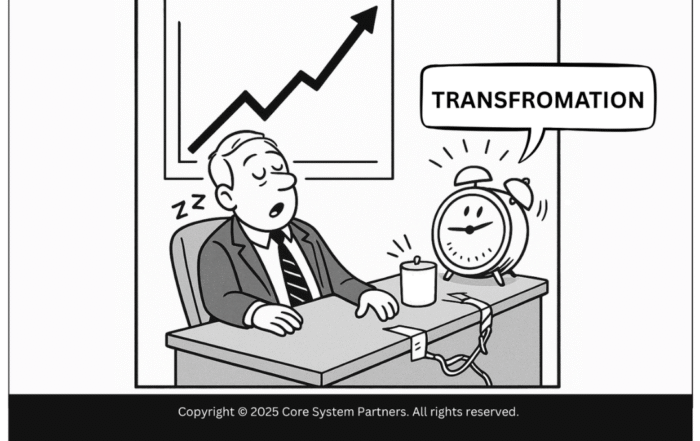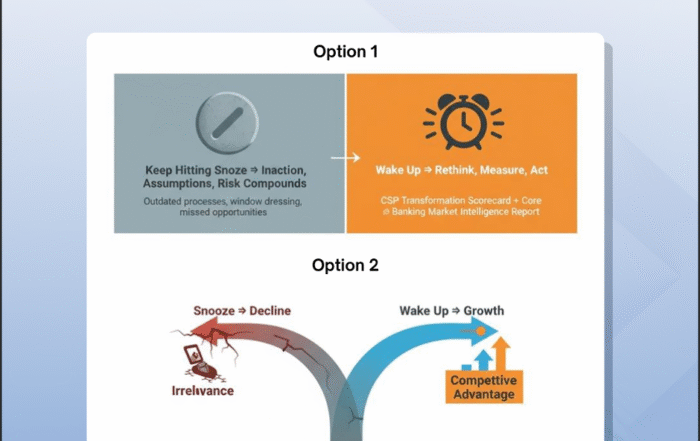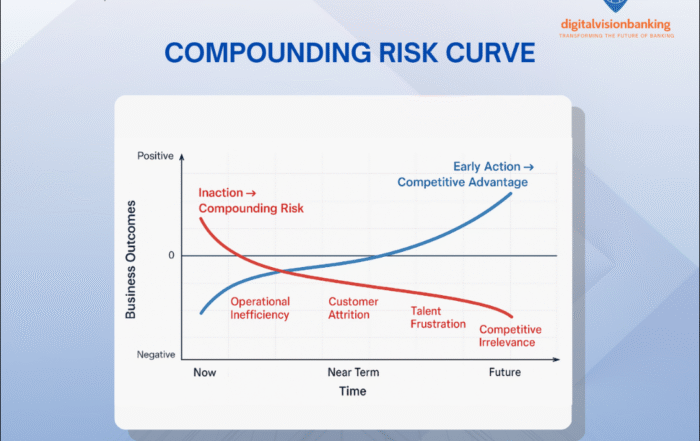
Tempted to rip and replace your core? Read this first. Learn why modernization doesn’t have to mean starting from scratch—and how to avoid the hidden risks of full replacement.
TL;DR – The Hidden Risks of Ripping and Replacing Your Core
-
Disruption Runs Deep – Core replacement often derails operations, customer experience, and internal focus.
-
Strategic Debt Is Real – Rushing into a rebuild without alignment can lock in decisions that don’t scale.
-
Integration Nightmares Await – Connecting a new core to existing systems can trigger cascading complexity.
-
Cultural Resistance Slows Momentum – Change fatigue, misalignment, and talent gaps can quietly sabotage delivery.
-
Why It Matters – Recognizing these hidden risks early helps banks avoid costly missteps and build transformation strategies that actually work.
Why a Full Core Replacement Isn’t Always the Silver Bullet
Ever stare at your aging core banking system and think, “If we just rip the whole thing out and start fresh, everything will be better”? You’re not alone. For many banks, the temptation to go for a full core replacement is strong. After all, who doesn’t want something faster, sleeker, and easier to manage?
But here’s the thing: ripping out your core isn’t always the fresh start it seems. It’s one of the riskiest, most expensive, and most complex decisions you can make as a bank. We’re talking about high-stakes moves that can disrupt daily operations, rack up unforeseen costs, and put your reputation—and customer relationships—on the line.
Before you commit to the “rip and replace” route, it’s worth hitting pause and taking a clear-eyed look at the risks, and the smarter alternatives that might serve you better.
1. Operational Disruptions & Downtime
The Hidden Cost of Hitting Pause on Banking as Usual
Let’s be honest. No customer wants to hear, “Sorry, our systems are down,” while trying to check their balance or make a payment. Yet, that’s exactly the risk when you swap out your core.
What Banks Often Get Wrong
- Thinking “go live” will be smooth sailing.
- Underestimating the downtime that comes with data migration and system testing.
- Forgetting how quickly customer trust erodes when services aren’t available.
The Reality
Core replacements have a nasty habit of introducing unexpected downtime. Data migrations, configuration bugs, and system kinks are common—and they hit hardest when your customers are least patient. In fact, according to the Federal Reserve Bank of Kansas City, a poorly planned transition can lead to major customer churn and brand damage.
How You Can Get Ahead
- Think phases, not floods. A component-based or phased rollout reduces the disruption.
- Parallel testing is your best friend. Get those bugs sorted before go-live.
- Over-communicate with customers. Set clear expectations, and deliver plenty of updates along the way.
Source: Federal Reserve Bank of Kansas City
2. Data Migration Complexities
It’s Not a Lift-and-Shift—It’s Brain Surgery
If you think migrating decades of data is easy, I have a bridge to sell you.
What Banks Often Get Wrong
- Assuming data migration is a simple copy-paste.
- Ignoring data integrity risks, like duplication, corruption, or even loss.
- Overlooking security gaps during the transfer process.
The Reality
Data migration is a high-wire act. One slip, and years—sometimes decades—of customer records can get compromised. Worse? During this delicate phase, fraudsters love to exploit system gaps. According to NetGuardians, this is when fraud risk spikes.
How You Can Get Ahead
- Clean house first. Pre-migration audits help you scrub and standardize data.
- Wrap your data in armor. Use encryption and strict access controls.
- Test. Then test again. Multiple practice runs uncover problems before they become disasters.
3. Resource Allocation & Expertise Gaps
Finding the Right People Is Half the Battle (And Twice the Cost)
COBOL isn’t exactly the hottest programming language on the block anymore—but many legacy cores still run on it. Now try finding developers who can bridge that knowledge into a next-gen system.
What Banks Often Get Wrong
- Assuming internal teams can handle the workload and complexity.
- Underestimating the learning curve for new systems.
- Failing to budget for consulting help and recruitment costs.
The Reality
The talent pool for legacy and modern core systems is shrinking fast. Banks that jump into a rip-and-replace without a talent strategy end up scrambling for expertise—and paying a premium. Finextra notes that staff shortages are among the biggest reasons projects stall or fail.
How You Can Get Ahead
- Upskill your people early. Don’t wait for go-live to start training.
- Bring in experienced vendors who’ve done this dance before.
- Explore API and cloud-based solutions that reduce reliance on legacy languages altogether.
4. Integration Challenges with Existing Systems
The Digital Equivalent of Moving House… And Realizing Nothing Fits
Replacing your core is like buying all new furniture without measuring the doorframes.
What Banks Often Get Wrong
- Thinking everything will integrate without a hitch.
- Ignoring dependencies like payments, CRM, and regulatory reporting systems.
- Not budgeting for custom development to connect new and old systems.
The Reality
Banks typically run dozens of interconnected systems. If these aren’t factored into your new core rollout, expect costly delays and operational chaos. Finextra reports that poor integration planning is a leading cause of overruns.
How You Can Get Ahead
- Do a thorough integration audit. Map every system and workflow.
- Use middleware. It helps bridge the old with the new.
- Test end-to-end functionality. Don’t assume—it’s better to know.
5. Regulatory Compliance & Security Risks
You Can’t Afford to Drop the Ball on This One
New core doesn’t mean automatically compliant. In fact, it can introduce new vulnerabilities.
What Banks Often Get Wrong
- Believing vendors when they say compliance is “built-in.”
- Forgetting about ongoing security updates and audits.
- Underestimating the cost of fine-tuning for regional regulations.
The Reality
Regulatory landscapes shift constantly. Sopra Banking warns that compliance blind spots can lead to penalties, audits, and even shutdowns. Cyber threats also spike during major transitions.
How You Can Get Ahead
- Involve compliance teams from day one.
- Invest in next-gen security. Protect data integrity during and after migration.
- Monitor everything in real time. Early alerts help catch issues before regulators do.
Final Thoughts: Rethinking the Rip-and-Replace Mindset
Core replacement might sound bold and decisive—but it’s not always the smartest move. Modernization doesn’t have to mean starting from scratch. Incremental optimization, component upgrades, and middleware can deliver a lot of the benefits without the massive risk and disruption.
It’s about balancing innovation with operational stability—keeping your bank competitive without sacrificing customer trust or financial control.
Ready to See Where You Stand?
Before you make any decisions, you need the full picture.
Take the OptimizeCore® Scorecard to evaluate your core system’s risks, opportunities, and best paths forward.
Because a clear plan beats a risky overhaul—every time.
#CoreBankingTransformation #CoreBankingOptimization





